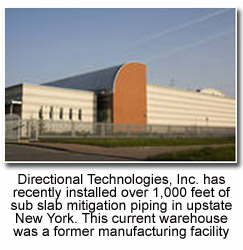Where Is Vapor Intrusion a Concern?
Vapor Intrusion is a potential concern at any building – existing or planned, located near soil or groundwater contaminated with volatile organic compounds. Examples include current and former manufacturing and chemical processing plants, warehouses, landfills, coal gasification plants, train yards, dry cleaners, gas stations, petroleum refineries, and terminal facilities.
How Are Vapors Mitigated?
The usual mitigation method is to depressurize the slab, extract the vapors and maintain negative pressure (vacuum) to ensure that any vapors migrating under the slab are captured and removed before they can enter the structure. This is similar to what is usually done to mitigate radon in residential basements. Typically, a subsurface extraction well vapor mitigation system consisting of slotted piping is installed either: 1) Vertically using conventional drilling technology and connected via a network of interconnecting piping or… 2) Horizontally via conventional excavation technology and then connected to a surficially-located vacuum source to extract the vapors from beneath the building slab.
How Do Conventional Mitigation Installation Technologies Fall Short?
Conventional installation technologies can fall short, especially when large structures such as factories, hangars and office buildings are involved, because they typically involve expensive and lengthy business disruptions. This is especially true if the slab is expansive, such as in a large factory, where a conventional system would need to be installed inside the structure. Installing vertical wells and inter-connecting piping inside a building can be very time consuming and disrupt or shut down business operations. Installing a mitigation system around the perimeter of a building using conventional excavation equipment can be equally disruptive and involve substantial site restoration costs.
How Can Horizontal Remediation Wells Enhance The Vapor Intrusion Mitigation Process?
Horizontal Remediation Wells are installed outside the building footprint and involve little to no business disruption.
The drill rig is set up in a location near the building and the horizontal remediation wells are installed horizontally beneath the structure, around the building perimeter (or both), depending on the building size and subsurface conditions. There is no need to disrupt business operations or move inventory to install vertical wells inside the building. There are minimal site restoration costs associated with horizontal remediation wells vapor mitigation systems. Additionally, horizontal remediation wells can provide better aerial subsurface coverage, ensuring that there are no “dead spots” where vapors can persist.